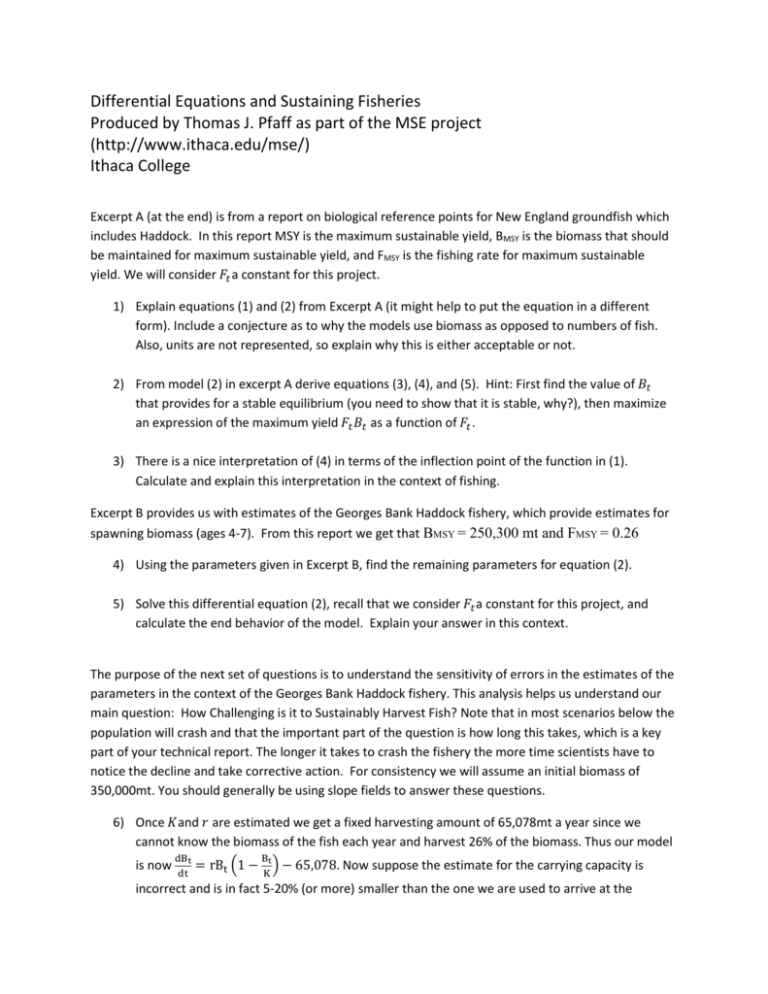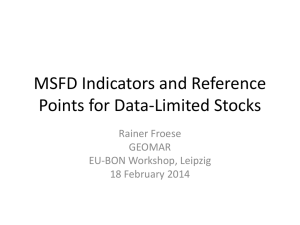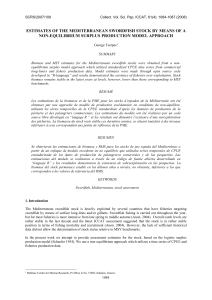Sustainable Fisheries
advertisement

Differential Equations and Sustaining Fisheries Produced by Thomas J. Pfaff as part of the MSE project (http://www.ithaca.edu/mse/) Ithaca College Excerpt A (at the end) is from a report on biological reference points for New England groundfish which includes Haddock. In this report MSY is the maximum sustainable yield, BMSY is the biomass that should be maintained for maximum sustainable yield, and FMSY is the fishing rate for maximum sustainable yield. We will consider 𝐹𝑡 a constant for this project. 1) Explain equations (1) and (2) from Excerpt A (it might help to put the equation in a different form). Include a conjecture as to why the models use biomass as opposed to numbers of fish. Also, units are not represented, so explain why this is either acceptable or not. 2) From model (2) in excerpt A derive equations (3), (4), and (5). Hint: First find the value of 𝐵𝑡 that provides for a stable equilibrium (you need to show that it is stable, why?), then maximize an expression of the maximum yield 𝐹𝑡 𝐵𝑡 as a function of 𝐹𝑡 . 3) There is a nice interpretation of (4) in terms of the inflection point of the function in (1). Calculate and explain this interpretation in the context of fishing. Excerpt B provides us with estimates of the Georges Bank Haddock fishery, which provide estimates for spawning biomass (ages 4-7). From this report we get that BMSY = 250,300 mt and FMSY = 0.26 4) Using the parameters given in Excerpt B, find the remaining parameters for equation (2). 5) Solve this differential equation (2), recall that we consider 𝐹𝑡 a constant for this project, and calculate the end behavior of the model. Explain your answer in this context. The purpose of the next set of questions is to understand the sensitivity of errors in the estimates of the parameters in the context of the Georges Bank Haddock fishery. This analysis helps us understand our main question: How Challenging is it to Sustainably Harvest Fish? Note that in most scenarios below the population will crash and that the important part of the question is how long this takes, which is a key part of your technical report. The longer it takes to crash the fishery the more time scientists have to notice the decline and take corrective action. For consistency we will assume an initial biomass of 350,000mt. You should generally be using slope fields to answer these questions. 6) Once 𝐾and 𝑟 are estimated we get a fixed harvesting amount of 65,078mt a year since we cannot know the biomass of the fish each year and harvest 26% of the biomass. Thus our model is now dBt dt = rBt (1 − Bt )− K 65,078. Now suppose the estimate for the carrying capacity is incorrect and is in fact 5-20% (or more) smaller than the one we are used to arrive at the harvesting rate. Change the model appropriately and find the limiting behavior. If the population crashes how long does it take to crash? Describe the overall qualitative behavior of the system as the carrying capacity changes. What is the relationship between a reduction in the carrying capacity and the years to crashing (linear, exponential, etc.). 7) Now suppose that the fishing rate was overestimated and hence the fish growth rate is too high. We will continue to fish at a constant amount of 65,078mt a year, but now reduce the intrinsic growth rate by 5% to 20%. . If the population crashes how long does it take to crash? Describe the overall qualitative behavior of the system as the growth rate is reduced. What is the relationship between a reduction in the growth rate and the years to crashing (linear, exponential, etc.). How much do we need to reduce the growth rate to crash in less than 10 years? 8) Again suppose that the fishing rate was overestimated and hence the fish growth rate is too high. We will continue to fish at a rate of 0.26 instead of a fixed fishing amount, but with a reduced intrinsic growth rate of 5% to 20%. If the population crashes how long does it take to crash? Again describe the qualitative behavior of the system. 9) Assume that all model parameters are correct but that some illegal fishing takes place. You should analyze this in two ways. First assume a slightly higher fishing rate (an extra 1%-5%). Second, assume a fixed take each year of an extra 1%-5% of BMSY. You should also consider both situations. In both cases make the appropriate adjustments to the model and answer the question, if the population crashes how long does it take to crash? 10) Create a reasonable worst case scenario for this fishery. Describe your model and provide your analysis. 11) Summarize your analysis in (5)-(8) and include any thoughts or concerns you have about the modeling and make policy suggestions. Also answer the question, is a model with a fast crash of 10 years a better or worse situation that a model that has a crash in 30-40 years. 12) Read http://www.bbc.com/future/story/20120920-are-we-running-out-offish?selectorSection=science-environment and comment on this article related to what you id here. Excerpt A from: Final Report of the Working Group on Re-Evaluation of Biological Reference Points for New England Groundfish (2002), http://www.nefsc.noaa.gov/nefsc/publications/crd/crd0204/ (section on Estimation & Projection Methodology) 2.2 Surplus Production Assessments Biomass Dynamics Analyses A nonequilibrium surplus production model incorporating covariates (ASPIC; Prager 1994, 1995) was applied to each stock using landings (and discards where available) and multiple survey indices of stock biomass. The model assumes logistic population growth, in which the change in stock biomass over time (dBt/dt) is a quadratic function of biomass (Bt): 𝑑𝐵𝑡 𝑑𝑡 𝑟 = 𝑟𝐵𝑡 − ( ) 𝐵𝑡2 𝐾 (1) where r is intrinsic rate of population growth, and K is carrying capacity. For a fished stock, the rate of change is also a function of fishing mortality (F): 𝑑𝐵𝑡 𝑑𝑡 𝑟 = (𝑟 − 𝐹𝑡 )𝐵𝑡 − ( ) 𝐵𝑡2 𝐾 (2) Biological reference points can be calculated from the production model parameters: MSY = K r / 4 BMSY = K / 2 FMSY = r / 2 (3) (4) (5) Initial biomass (expressed as a ratio to BMSY: B1R), r, MSY, and catchability of biomass indices (q) were estimated using nonlinear least squares of survey residuals. Biomass indices from research surveys or commercial catch rate contributed as independent biomass indices. Survey residuals were randomly resampled to approximate precision and model bias through bootstrap analysis. Excerpt B from: Stock Assessment of Georges Bank Haddock, 1931-2004 by Brodziak, Traver, Col, and Sutherland (http://www.nefsc.noaa.gov/nefsc/publications/crd/crd0611/) 5.1. Biological Reference Points For Georges Bank haddock, spawning biomass (BMSY) and the fishing mortality to produce MSY (FMSY) are BMSY = 250,300 mt and FMSY = 0.26 (NEFSC 2002). The overfished threshold (BTHRESHOLD) for Georges Bank haddock is BTHRESHOLD = ½ BMSY = 125,200 mt. The overfishing threshold (FTHRESHOLD) for Georges Bank haddock is FTHRESHOLD = FMSY = 0.26.









